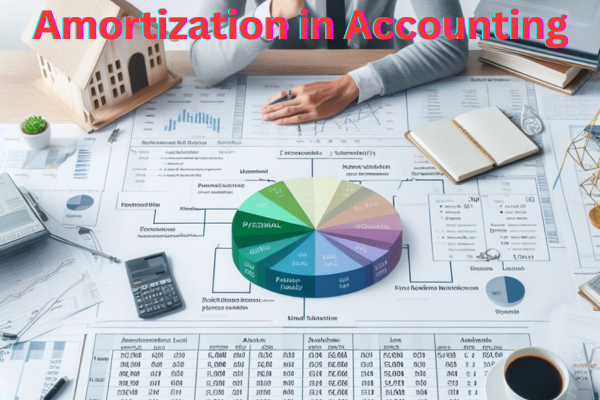Contents
Introduction of Amortization in Accounting
Amortization in accounting is a notion that performs an indispensable position in recognizing and spreading the price of intangible belongings over their beneficial life. In less complicated terms, it is like spreading the fee of a price over time rather than recognizing it all at once. Let’s delve into the importance, advantages, and facets of amortization in accounting.
What is Amortization in Accounting?
Amortization is the system of allocating the price of intangible assets, like patents, copyrights, or trademarks, over a particular period. Unlike tangible property (physical items), intangible property supplies long-term advantages however regularly has a restrained lifespan. Therefore, spreading the price of these belongings over their beneficial existence displays a greater correct photo of an entity’s monetary health.
Importance of Amortization in Accounting
1. Accurate Financial Reporting:
Amortization ensures that a commercial enterprise precisely displays the consumption of intangible property over time, contributing to extra particular economic statements.
2. Matching Expenses to Revenue:
By spreading expenses over the asset’s beneficial life, amortization helps align prices with the revenues generated by way of the asset. This precept adheres to the matching thinking in accounting.
3. Compliance with Accounting Standards:
Many accounting standards, such as Generally Accepted Accounting Principles (GAAP) and International Financial Reporting Standards (IFRS), mandate the use of amortization to record intangible assets.
4. Asset Valuation:
Amortization assists in retaining sensible asset values on the stability sheet, stopping overstatement of assets’ well-being over time.
Advantages of Amortization in Accounting
1. Smoothing Expense Impact:
Amortization prevents a vast effect on the profit announcement in the years. of acquisition, merchandising economic stability.
2. Better Decision Making:
Spread-out prices assist in greater correct cost-benefit analyses, assisting the administration in making knowledgeable choices about asset administration and acquisitions.
3. Tax Benefits:
Amortization is regularly tax-deductible, supplying corporations with conceivable tax blessings and lowering the common tax burden.
4. Transparent Financial Statements:
Amortization contributes to obvious and without difficulty comprehensible monetary statements, improving the credibility of a corporation in the eyes of stakeholders.
Features of Amortization in Accounting
1. Scheduled Payments:
Amortization includes a predetermined timetable for allocating the value of an intangible asset. This is primarily based on the asset’s estimated beneficial life.
2. Calculating Amortization Expense:
The amortization cost is calculated with the use of a systematic method, such as the straight-line approach or the declining stability method. Each approach spreads the value over time in a one-of-a-kind way.
3. Adjustment for Residual Value:
Some properties can also have a residual price at the cease of their beneficial life. Amortization considers this residual cost when calculating the complete expense.
4. Periodic Reporting:
Amortization is stated on the profit’s assertion at ordinary intervals, imparting stakeholders with a clear appreciation of the ongoing influence of intangible asset expenses.
5. Documentation and Compliance:
Proper documentation of amortization schedules and adherence to accounting requirements ensure compliance with regulatory necessities and auditing standards.
How Amortization Works
Now, let’s take a closer appear at the mechanics of amortization. The procedure entails figuring out the beneficial lifestyles of the asset and the technique of amortization. Common strategies encompass straight-line amortization, the place where the price is unfolded equally over every period, and the declining stability method, the place where a greater component of the value is expensed in the early periods.
1. Useful Life Determination:
The beneficial existence represents the estimated time in the course of which the asset will make contributions to the business. This dedication includes elements like technological obsolescence, felony or contractual limits, and the predicted use of the asset.
2. Straight-Line Amortization:
In this method, the equal quantity of amortization cost is diagnosed in every accounting period. It’s an easy strategy appropriate for a property with a steady contribution to revenues.
3. Declining Balance Amortization:
Unlike straight-line, declining stability strategies front-load the amortization expense. This is regularly used for properties that supply greater vast cost in the until now years.
4. Journal Entries:
The accounting entries for amortization contain debiting the amortization cost and crediting the accrued amortization account. These entries are made frequently at some point in the asset’s beneficial life.
Common Misconceptions about Amortization
Despite its importance, amortization is every so often misunderstood. Let’s tackle a few frequent misconceptions:
1. Amortization is the Same as Depreciation:
While each amortization and depreciation contain the allocation of charges over time, depreciation particularly relates to tangible belongings like equipment or buildings. Amortization, on the other hand, offers intangible assets.
2. Amortization Equals Cash Flow:
The amortization rate recorded in the economic statements does not always symbolize a true outflow of cash. It’s an accounting adjustment to precisely mirror the asset’s diminishing value.
3. Amortization is Only for Large Corporations:
Businesses of all sizes, along with small enterprises, use amortization. Any entity with intangible assets, regardless of scale, advantages from precisely representing these assets’ charges over time.
Conclusion:
In conclusion, amortization in accounting is now not simply a technical process; it is a vital thing of monetary management. Its significance lies in presenting a greater correct illustration of a business’s monetary health, its benefits prolong to higher decision-making and conceivable tax benefits, and its aspects consist of scheduled payments, particular calculation methods, and compliance considerations. Understanding and correctly imposing amortization is quintessential for groups aiming for obvious monetary reporting and sustainable economic success.

Leave a Reply